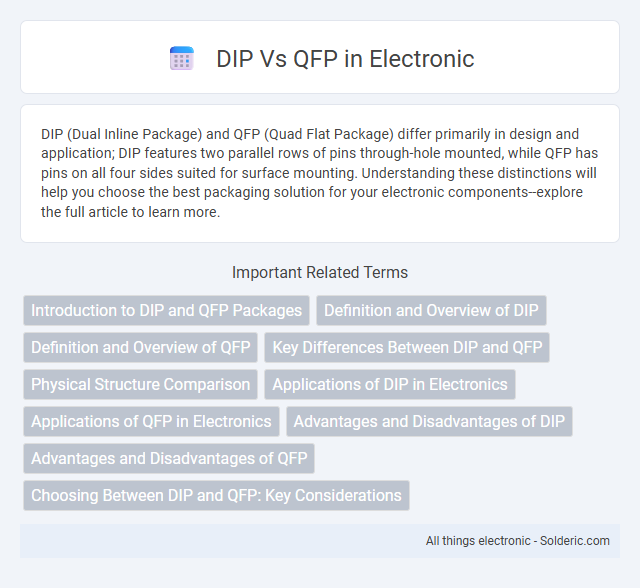DIP (Dual Inline Package) and QFP (Quad Flat Package) differ primarily in design and application; DIP features two parallel rows of pins through-hole mounted, while QFP has pins on all four sides suited for surface mounting. Understanding these distinctions will help you choose the best packaging solution for your electronic components--explore the full article to learn more.
Comparison Table
| Feature | DIP (Dual In-line Package) | QFP (Quad Flat Package) |
|---|---|---|
| Package Type | Through-hole | Surface-mount |
| Pin Configuration | Two parallel rows | Pins on all four sides |
| Pin Count | Typically up to 64 pins | Typically 32 to 208 pins |
| Footprint Size | Larger due to through-hole mounting | Compact, suitable for high-density PCB |
| Mounting Method | Inserted into PCB holes, soldered | Mounted directly on PCB pads, soldered |
| Thermal Performance | Good heat dissipation via leads | Moderate, depends on pad design |
| Cost | Lower cost for prototyping | More cost-effective for mass production |
| Application | Prototyping, low pin count ICs | High pin count ICs, compact devices |
| Assembly | Manual or wave soldering | Automated pick-and-place, reflow soldering |
Introduction to DIP and QFP Packages
Dual In-line Package (DIP) features rectangular housing with two parallel rows of through-hole pins designed for easy manual soldering and prototyping. Quad Flat Package (QFP) offers a flat, square form with leads extending from all four sides, optimized for high-density surface mounting on printed circuit boards (PCBs). DIP suits low pin-count applications and prototyping, while QFP supports complex, high-pin-count integrated circuits requiring compact PCB real estate.
Definition and Overview of DIP
Dual In-line Package (DIP) is a type of integrated circuit packaging featuring a rectangular housing with two parallel rows of pins extending perpendicularly from the package body to facilitate through-hole mounting on printed circuit boards. DIP packages are known for their ease of manual assembly and prototyping, making them prevalent in older or educational electronics designs. Unlike Quad Flat Package (QFP), which has pins on all four sides for surface mounting, DIP maintains a simpler pin layout suited for socket insertion and robust mechanical connections.
Definition and Overview of QFP
Quad Flat Package (QFP) is a surface-mount integrated circuit package characterized by its thin, flat body and leads extending from all four sides, enabling compact and efficient board layouts. Unlike Dual In-line Packages (DIP) which are through-hole mounted, QFPs allow higher pin counts and better electrical performance due to shorter lead lengths. Your choice between DIP and QFP depends on factors such as manufacturing processes, assembly methods, and space constraints.
Key Differences Between DIP and QFP
DIP (Dual In-line Package) features two parallel rows of through-hole pins suited for easy prototyping and repair, while QFP (Quad Flat Package) offers a flat, surface-mount style with pins on all four sides, enabling higher pin density and compact circuit designs. DIP packages typically handle lower pin counts and are less suitable for modern miniaturized electronics compared to QFP's ability to support complex integrated circuits with dozens to hundreds of pins. Your choice between DIP and QFP depends on factors like assembly method, space constraints, and required pin count for your electronic project.
Physical Structure Comparison
DIP (Dual In-line Package) features two parallel rows of pins extending perpendicularly from a rectangular housing, making it suitable for through-hole mounting on PCBs. QFP (Quad Flat Package) presents a flat, square shape with pins extending from all four sides in a gull-wing style, designed primarily for surface-mount technology. The compact, low-profile design of QFP allows for higher pin counts and greater circuit density compared to the bulkier, vertically-oriented DIP format.
Applications of DIP in Electronics
DIP (Dual In-line Package) components are widely used in prototyping, educational kits, and through-hole PCB assemblies due to their ease of handling and soldering. Their robust design suits applications in microcontrollers, DIP switches, and memory modules where durability and manual mounting are crucial. Your electronics projects benefit from DIP's straightforward installation and reliable connections in low to medium-frequency circuits.
Applications of QFP in Electronics
QFP (Quad Flat Package) is widely used in high-density electronic applications such as microcontrollers, microprocessors, and digital signal processors due to its compact footprint and efficient heat dissipation. It enables surface-mount technology (SMT) assembly, making it essential in modern consumer electronics, automotive control systems, and telecommunications equipment. The QFP package supports fine-pitch leads, allowing precise connections in complex integrated circuits, unlike DIP (Dual In-line Package), which is bulkier and suited for simpler or legacy designs.
Advantages and Disadvantages of DIP
Dual In-line Package (DIP) offers straightforward soldering and easy manual handling, making it ideal for prototyping and repairs. Its larger size enables better heat dissipation but limits high-density circuit designs compared to Quad Flat Package (QFP). However, DIP's bulkiness and lower pin count hinder advanced applications requiring compact and high-pin-count components.
Advantages and Disadvantages of QFP
QFP (Quad Flat Package) offers advantages such as a smaller footprint than DIP (Dual In-line Package), allowing for higher component density on PCBs and improved electrical performance due to shorter lead lengths. However, QFP packages are more challenging to solder and handle, requiring precise surface-mount technology and often specialized equipment. Your choice of QFP is ideal for compact, high-performance designs but may involve higher assembly costs and complexity compared to the easier-to-manage DIP format.
Choosing Between DIP and QFP: Key Considerations
When choosing between DIP (Dual In-line Package) and QFP (Quad Flat Package), consider factors like board space, pin count, and assembly method. DIP offers easier manual soldering and is suitable for prototyping, whereas QFP provides higher pin density and supports automated assembly, making it ideal for compact, high-performance circuits. Your decision should balance requirements for durability, thermal performance, and manufacturing scale to optimize your electronic design.
DIP vs QFP Infographic

 solderic.com
solderic.com